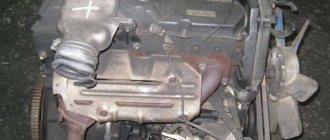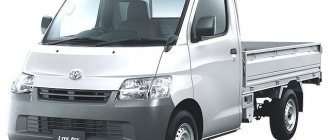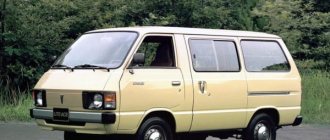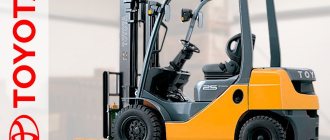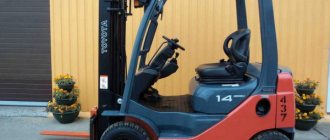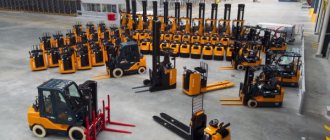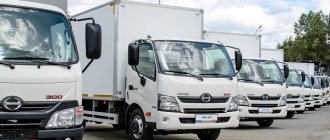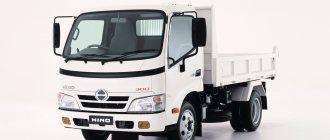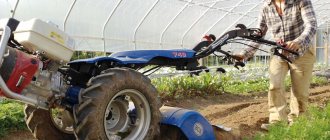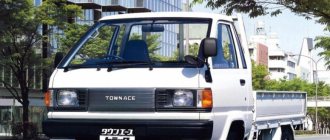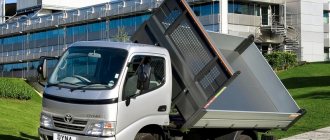Toyota Toyoace is a commercial truck that is in quite high demand in the Russian market. The main distinguishing feature of this model is its fairly high performance.
The first samples were released back in 1959. Since then, this car has been one of the most popular in its segment. The manufacturer updates the model almost every 4 years, both in technical terms and in terms of appearance.
For the modern market, Toyota Toyoace is offered in two main variations, namely shortened and extended versions.
First generation Toyopet/Toyoace
From 1954 to 1960, the first generation Toyoace light cars were produced. They were compact semi-cabin trucks capable of carrying up to one ton of cargo.
Engine – four-cylinder sidevalve, in-line, “type S”. Working volume – one liter (995 cubic centimeters); power - 30 horsepower (22 kilowatts). They were put on sale under the name “Toyopet Light Truck” (pet – “pet”). But soon a public competition for a new name was announced. This is how the Toyoace brand appeared in 1956.
The interior of the driver's workplace was spartan even by the unassuming standards of the time. The seats are made in the form of hammocks, like in the Citroën 2CV. Despite their ultra-economical performance, the first Toyota Toyoace still sold poorly at the beginning of its journey - due to the fact that it was more expensive than the three-wheeled scooter trucks with which it competed.
However, after a significant price reduction, when Toyota began selling cars of this model with a minimal margin, it was Toyoace that began to change the Japanese light commercial truck market in favor of four-wheeled vehicles.
Things took off, the truck became popular, and based on the standard model, a whole family was also developed, consisting of different variants: a van, a light van, a car with a double cab, and so on.
In 1958, the power of the Type S engine was increased to 33 hp. (24 kW). The first generation of Toyota Toyotas was mass-produced until July 1960.
Owner reviews
Vladimir, Novosibirsk, Toyota Toyota Ace 1998
The car was brought from Primorye with a mileage of 300,000 kilometers. I immediately changed the timing belt, nozzles, oils, of course, some little things. The condition of the car is very good, not rotten, not leaking. There is no need to repair the engine yet, it works exactly like a clock. In winter it starts well, even if it has been standing for a long time. It does not eat oil, nor does it eat fuel. Diesel consumption is about 10 liters per hundred square meters. I use the car often - I carry small loads and constantly go to the dacha to deliver building materials. The car is what they call “get in and go.” The rubber is Velcro, many people criticize them, but from my own experience I will say that on wet roads and for country roads more “spikes” are suitable. Moreover, there is less noise and consumption is the same as on summer wheels. In addition to Toyota Toyota Ace, I looked at a similar Toyota Dune and the Atlas model, but I liked this one better. Among the advantages - it picks up speed well, has a small turning radius, and when empty it doesn’t rattle. The cabin is quiet and there is a lot of free space, there is room to put the tools. An air conditioner is installed - it’s a pleasure to drive in the summer. The automatic drives easily and smoothly, even when fully loaded. The car is not new, of course, but for now I’m not even thinking about buying another one. After all, a Japanese car is a durable and hard-working thing. There have been no problems with spare parts and services for a long time, repairs are not as expensive as before, although Toyota services are not favored because of the inconvenience of access to spare parts in the car.
More on the topic: Toyota Hayes mini-truck: the trump card of the Japanese auto industry
Second generation Toyoace
The production of the updated Toyota Toyotas began in March 1959, and the following year this model replaced the previous generation on the assembly lines. Toyota Toyoace II received a new, more powerful engine: 1.0-liter with 45 hp. (33 kW), "type P".
During mass production, trucks with increased payload capacity were added to the product line of this family: 1.25 and 1.5 tons, with more powerful engines: 1.2 liters of displacement (2P) and 1.5 liters (R).
In 1966-1967 The manufacturing company has carried out a major modernization and facelift of this family. Another engine version was added: 3P with a capacity of 1.35 liters. In addition, unlike front-engine Toyota Toyotas, the engine in the second generation Toyoace gradually “moved” to the space under and behind the seats.
The cabin began to tilt forward to provide free access to the engine. The previously split windshield has now been replaced with one piece of glass, but still flat and not curved. The cab of the truck could now accommodate three people instead of two. In this significantly updated version, Toyota Toyotas lived a long and commercially successful life, remaining on the global automotive market until 1971.
Recommendations
- "國瑞汽車股份有限公司 KUOZUI MOTORS, LTD." Kuozui.com.tw. Retrieved 2010-12-19.
- "Grupo Salvador Caetano". Retrieved 2011-02-04.
- Toyota: A History of the First 50 Years
. Toyota Motor Corporation. 1988. pp. 136–137. ISBN 0-517-61777-3. - "Massi Dina: origin of the name." 75 Years of Toyota: Vehicle Lineage
. Toyota Motor Co. Retrieved 2013-01-16. - "Affiliates (100% subsidiaries of Toyota) - Toyota Motor East Japan, Inc." Toyota Motor Corporation. 2012. Retrieved 2014-07-21.
- "Toyopet Light Truck SKB (Toyoas)." 75 Years of Toyota: Vehicle Lineage
. Toyota Motor Co. Retrieved 2013-01-16. - “トヨタ自動車販売 (株)『モータリゼーションともに.” 資料』(1970.11)" [Document Toyota Motor Sales Co., Ltd. "With motorization" (1970.11)]. Shibusawa Shashi Database
(in Japanese). Shibusawa Eiichi Memorial Fund. p. 126. Archived from the original on 2019-12-23. - Piston Ring Sets Price List
(PDF),
18
, Tokyo, Japan: Riken Corporation, November 2008, page 70, archived from the original (PDF) on 2013-05-31 - 質 [ Quality and Value at Your Service from Toyota
] (brochure) (in Japanese), Japan: Toyota, 1966, p. 7 - ^ a b Toyota Commercial Vehicles
(Catalogue), Toyota, 1969, p. 9 - [Manufacture of cute cars .
Toyota dares to challenge tomorrow. ] (catalog) (in Japanese), Toyota Motor Co., 1972, p. 6 - "'69 "[Commercial Vehicles '69: New Models].月刊自動車 [Monthly Motor Magazine]
(in Japanese).
11
(8): 122. August 1969. 3439. - Toyota Dyna 2 Ton
(brochure), Australia: Toyota Motor Co., Ltd., 1965, p. 3 - Toyota Catalog (1972), item 8
- 自動車ガイドブック
[
Car Guide 1976/1977
] (in Japanese),
23
, Japan: Japan Automobile Manufacturers Association, 1976-10-20, p. 212, 0053-760023-3400 - Automobile guide 1976/1977
, paragraph 268 - Brown, Robin, ed. (July 13, 1971). "Daihatsu will return to the automotive field." Canberra Times
. item 13. Received January 18, 2015. - Rohrbach, Hans W., ed. (1982), Internationaler Nutzfahrzeug-Katalog (Inufa) 1982
[
International Commercial Vehicle Catalog
] (in German),
24
, Solothurn, Switzerland: Vogt-Schild AG, pp. 114–115. - ^ a b
Faulkner, Sam (2018-02-06).
“Chinese car brands that time has forgotten: car Mengenal Toyota Dyna Rino, Armada Bongsor Pos Indonesia Zaman Dahulu.” kabaroto.com
(in Indonesian). Received 2020-07-25. - Wright, Cedric, ed. (August 1978). "Cars of the World 1978". CAR (South Africa)
. Vol. 22 no. 7. Ramsay, Son & Parker (Pty) ltd. paragraph 20. - "Daihatsu launches new line." Bananacoast Opinion
: 3. 1977-12-28. - "Toyota unveils complete replacement for Dyna truck model." Toyota
. 1984-09-03. Received 2020-07-25. - ^ a b c d f g
"TOYOTA DYNA: Which used car version do you like?
" www.cardealpage.com
. 2018-04-13. Received 2020-07-25. - “Complete model changes for Dyna, ToyoAce and HiAce trucks.” Toyota
. 1995-05-11. Received 2020-07-25. - ^ a b
Soares de Oliveira, Paolo (7 April 2003).
"Toyota sends Portuguese Dyna to rest of Europe." Car news
. Crane Communications. - Machado Magalhães, Antonio (9 March 2015). “Salvador Caetano troca produção da Dyna por Land Cruiser” [Salvador Caetano switches production from Dyna to Land Cruiser]. Automatic monitoring
(in Portuguese). Archived from the original on 2019-09-07.
Third generation Toyoace / HiAce / Toyopet Store
The third generation Toyoace was introduced in August 1971 and immediately appealed to potential buyers with its much more modern and “advanced” design. From the very beginning of mass production, several new body styles were developed, as well as new gasoline engines such as 3P and 12R (with a working volume of 1.35 or 1.6 liters, power up to 83 hp (61 kW).
In addition to gasoline engines, a 2.5-liter 2J diesel engine with a power of 70 horsepower (51 kW) also appeared. This diesel engine was first introduced in July 1972.
The payload of the truck has also increased. In the third generation, it now began to range from 850 kg to 2,000 kg. In August 1977, they began producing a special lowered version of the truck - with small dual rear wheels to ensure lower and more convenient loading / unloading.
An important point: starting from this (third) generation, the Toyota Toyota chassis began to be used as the basis for the production of all-metal commercial vans and minibuses for transporting passengers. They were sold under the names Toyota HiAce, as well as Toyopet Store (but this is only in the Japanese domestic market).
Fourth generation Toyoace / QuickDelivery
The fourth generation Toyota Toyota was produced from March 1979 to August 1985. It was the last Toyota Toyoace to be developed and produced separately from the larger Dyna family of commercial trucks.
The overall dimensions of the vehicle and its loading platform remained the same as the previous series. But Toyota engineers shortened the wheelbase by 345 mm, thereby ensuring a narrower turning radius. But the version with a long wheelbase also remained available.
Then, for the first time, there was talk about the compliance of cars operating in the city with certain emission and noise standards. Toyota Toyoace successfully fit into these standards, introduced in 1979.
The 1.6-liter 12R engine was retained, although its power was slightly reduced (to 80 horsepower (59 kW). The 2J diesel engine was also retained, but it was complemented by an all-new 2.2-liter SOHC engine with 72 hp. (53 kW) "type L".
A larger 2-liter 5R petrol engine was also used, but it was not widely used. After all, now diesel engines have begun to acquire increasing and then dominant importance in this type of car.
In 1982, the Toyota QuickDelivery van was introduced to the market and gained popularity, which allowed you to move directly inside the vehicle. This property was appreciated by workers of all kinds of delivery services and other industries in which working from inside the car, compactness and mobility are important advantages.
K170 (1963–1968)
The original semi-cab over Dyna was replaced by the new K170 series model in September 1963 with a more compact design with quad headlights. The Dyna RK170 also served as the basis for the Toyota RK170B light bus and was built on the Sturdy chassis. It also had a 1.9 liter Stout engine producing 80 hp. (59 kW). 3R-B engine. The Isuzu Elf introduced a diesel version in 1960, which proved successful enough to propel Dyna into second place in sales. Even the new Dyna did not restore Dyna's lead until the J-engine (2336 cc, OHV) diesel engine JK170 was added to the range in March 1964. A 2.5 tonne long wheelbase version with twin rear wheels (RK175) was also available, as was a shuttle van (glazed minivan) version.[9]
Fifth generation Toyoace / HiAce / Dyna
Launched on the market in August 1985, the fifth generation Toyota was already made on the basis of the fifth generation Toyota Dyna, a family launched by Toyota a year earlier. At the same time, a clear division was observed according to the size of the car and its load-carrying capabilities: Toyoeys - light-tonnage vehicles with engines of smaller size and power, Dina - heavier versions of 2-3.5 tons, with slightly more powerful engines.
Toyoace one ton trucks have been discontinued. The presence of trucks under the names not only Toyoace, but also HiAce remained on sale. Buyers were also offered an option with a two-liter engine running on liquefied gas. Overall, the range of diesel engines has increased, up to a four-litre six-cylinder variant.
U60/Y50 series (1984-1994)
Toyota Dyna U60
2 - 3.5 tons
U60 - 90 series (1984–1994)
The first BU series (Dyna 200/300/400, 1984–88) used quadrangular round headlights. From 1989, the Dyna had quad rectangular headlights and one-piece door glass with new interior door trim and other minor interior changes. All wide cab models had a central roof vent and 3 windshield wipers. The 3.4 L, 3.4 L (direct injection) 13B and 3.7 L 14B direct injection diesel engines were used in the Dyna 200 and Dyna 300, a 5-speed gearbox was standard and a 4-speed automatic transmission with 2-way overdrive mode was available as an option. The Dyna 300 was equipped with an exhaust brake. Front vented twin-piston disc brakes were optional on the first wide-cab Dyna 300 series.[23][24] In Portugal, the Dyna 250 (BU84) with the 3B engine was assembled locally.
1 - 1.5 tons
Y50 and 60 series (1985–1995)
The lighter Y series was introduced in May 1985. Portuguese Salvador Caetano assembled the LY60 Dyna as a 150 using Toyota cars. 2L engine, 2.4 liter (2446 cc) diesel inline four cylinder engine.
Sixth generation Toyoace/Dyna
The sixth generation of the popular truck, introduced in May 1995) was already fully integrated with the Toyota Dyna. The chassis numbers were simply “Y series” for lighter models and “U series” for heavier versions. The only difference between Dyna and Toyoace in the second half of the 1990s was only the letters.
The range of options manufactured on the basis of the main Toyota Toyota/Dina chassis has expanded significantly, incorporating the range of models from the Hino Ranger FB family (Hino is also a division of Toyota). The lighter part of the line (“Y series”) remained on sale in the global car market until 2001, two years after the replacement of the heavier versions of the family.
U100, 200/Y100 series (1995–2002)
Toyota Dyna U200 Toyota Dyna Super Low Cab
The sixth generation Dyna was introduced on May 11, 1995. New engine additions included the 5.3-litre J05C direct injection diesel engine and the 4.1-litre 15B-F four-valve engine. Diesel engines have been designed to meet new vehicle emissions standards. Additions to the petrol engines included the 2.7-litre four-valve 3RZ-FE engine, as well as an LPG variant of the same engine coded 3RZ-FP.
Exterior changes included a new cabin design, as well as upgraded electrically operated door mirrors, new turn signals and new thermoplastic steel steps. Inside, new 31-degree adjustable seat belts have been added along with a new instrument panel. The braking system and suspension have been improved for improved performance. A new type of cab, called the grand cab, was added to the range in addition to the standard cab, which was similar to the 4.0 ton model but had increased deck space.[25]
In 1997, a new type of cab was added to the range called the Super Low Cab, in which the cab is located forward of the front axle. The cabin was moved forward 690 mm (27.2 in) and the floor was lowered 81 mm (3.2 in) to increase deck space.[24]
Like many other generations of Dyna, this generation was also assembled in Ovar, Portugal by local Toyota partner Cayetano for local sales.[26]
Seventh generation Toyoace/Dyna
In May 1999, heavier diesel versions (1.75-3.5 tons) were replaced by new seventh-generation Toyota Toyotas. The four-ton model is a new addition to the Toyoace line. In June 2001, Toyota specialists launched mass production of a replacement for lighter models - the seventh generation Toyoace.
Eighth generation Toyoace/Dyna
In June 2011, the eighth generation Toyota Toyoace compact trucks went on sale. In addition to diesel engines, hybrid engines have also appeared for several model variants. Toyota Toyotas received noticeable, but not radical changes in appearance and was equipped with various electronic systems (in particular, a collision avoidance system and a lane departure warning system).
The family has received many different changes, including the Common Rail electronic diesel fuel injection system; updated transmission, which includes a six-speed manual transmission and an automatic transmission with the same number of gears.
Story
The Toyopet Route Truck, whose mass production started in 1956, was chosen as the basis for the Toyota Toyoace. The manufacturer first introduced the Toyoace model itself three years later, in 1959. In 1963, the car was restyled. Then some dimensions were reduced.
In 1968, production of the third generation of this truck began. The updated model was offered to consumers in several versions, including a van, as well as a shortened and extended wheelbase.
Production of the fourth generation began in 1977. In 1984, fifth-generation cars began to roll off the assembly line, and in 1995, the sixth.
The seventh generation appeared on the market four years later, in 1999. The new car could have a maximum carrying capacity of either 1500 kilograms or 3000, depending on the modification.
The debut of the latest eighth generation took place in 2011. The model has received many different changes, including a new power unit with a CommonRail electronic fuel injection system. The transmission has also been updated to include a six-speed manual transmission, but an automatic transmission with an equal number of gears is also available as an optional extra.
Modifications of Toyota Toyoace
Among the standard Toyota Toyoace tadpole trucks, there are also semi-cab pickups. In addition to both, consumers can also choose various modifications of conventional manufactured goods or insulated vans used for distribution practice.
The Toyota Toyoace chassis also serves as the basis for the installation of all kinds of special superstructures: city garbage trucks, dump trucks, cranes, tow trucks, construction trailers, refrigerators and other special variations. A special option is the double cab version, which has an additional row of seats.
It should also be noted that in addition to cargo and cargo-passenger modifications, Toyota Toyoace cars were also produced as very comfortable minibuses and minivans.
Cabin Toyota Toyota
The interior of these cars, which remain in service, regardless of generation and (or) modification, is designed in a simple, discreet, comfortable and ergonomic manner. The interior decoration uses plastic and velor, which combine quite harmoniously. The standard cab has three seats, while modifications with a coupled cab have more seats.
The laconic dashboard contains only everything necessary to inform the driver. As standard, there are also electrically adjustable mirrors and electric windows.
Technical characteristics of Toyota Toyoace engines
Most of those trucks from the Toyota Toyoace family that remain in service today are equipped with in-line four-cylinder diesel engines - turbocharged or naturally aspirated, equipped with a Common Rail electronic fuel system; working volume 4.0 liters. Their standard cylinder diameter is 104 mm; piston stroke – 118 mm.
Diesel options:
- N04C-UM – power 116 hp, maximum torque 325 N.m (at 1400 rpm).
- N04C-TH – power 116 hp, maximum torque 284 N.m (at 1600 rpm).
- N04C-TJ – power 136 hp, maximum torque 353 N.m (at 1600 rpm).
- N04C-UN – power 136 hp, maximum torque 390 N.m (at 1400 rpm).
- N04C-TB – power 150 hp, maximum torque 392 N.m (at 1600 rpm).
- N04C-TK – power 150 hp, maximum torque 392 N.m (at 1600 rpm).
- N04C-UL – power 150 hp, maximum torque 420 N.m (at 1400 rpm).
- N04C-WD – power 150 hp, maximum torque 440 N.m (at 2380 rpm).
- N04C-WE – power 150 hp, maximum torque 470 N.m (at 2200 rpm).
- N04C-UP – power 150 hp, maximum torque 390 N.m (at 2600 rpm).
- N04C-VU – power 180 hp, maximum torque 470 N.m (at 2600 rpm).
- N04C-UQ – power 180 hp, maximum torque 480 N.m (at 1400 rpm).
- N04C-TL – power 180 hp, maximum torque 460 N.m (at 1600 rpm).
There are also cars with diesel engines of other displacements. For example, more:
- J05D-TB – displacement 4.7 l, power 180 hp, maximum torque 460 Nm (at 1600 rpm). Cylinder diameter – 112 mm, piston stroke – 120 mm.
- S05D-D – displacement 4.9 liters, power 135 hp, maximum torque 343 N.m (at 1600 rpm). Cylinder diameter – 112 mm, piston stroke – 120 mm.
...or, conversely, of a smaller volume:
- 2KD-FTV – displacement 2.5 l, power 102 hp, maximum torque 200 Nm (at 2200 rpm). Cylinder diameter – 92 mm, piston stroke – 93.8 mm.
- 2KD-FTV turbocharged - displacement 2.5 liters, power 144 hp, maximum torque 343 Nm (at 2800 rpm). Cylinder diameter – 92 mm, piston stroke – 93.8 mm.
- 1KD-FTV – displacement 3 l, power 190 hp, maximum torque 352 Nm (at 1400 rpm). Cylinder diameter – 98 mm, piston stroke – 103 mm.
Also on our roads you can find Toyota Toyoace trucks with gasoline injection four-cylinder engines (but they, of course, are in the minority):
- 1TR-FE – displacement 2.5 l, power 102 hp, maximum torque 200 Nm (at 2200 rpm). The cylinder diameter and piston stroke are 86 mm each.
- 2TR-FE – displacement 2.7 liters, power 148 hp, maximum torque 235 Nm (at 2800 rpm). The cylinder diameter and piston stroke are 95 mm each.
Even less common are Toyota Toyota trucks equipped with factory four-cylinder engines, originally designed to run on liquefied gas. These are the following models:
- 1TR-FPE – displacement 2.0 l, power 113 hp, maximum torque 186 Nm (at 3600 rpm). The cylinder diameter and piston stroke are 86 mm each.
- 1BZ-FPE – displacement 4.1 l, power 116 hp, maximum torque 306 N.m (at 2000 rpm). Cylinder diameter – 108 mm, piston stroke – 112 mm.
U600 and U800 series (2011–present)
Toyota Dyna U600 Hybrid
The eighth generation Dyna debuted in May 2011 and was based on the second generation Hino Dutro. The model range consists of U600 and U800. The exterior design is more aerodynamic and interior quality has improved compared to the previous generation. Hybrid models have a 4.0 L (4009 cc) diesel engine producing 150 hp. (110 kW) was coupled to a 49 hp electric motor. (36 kW), which also serves as a starter. A new 5-speed automatic transmission was introduced, which operated like a conventional automatic transmission with two paddle shifters on the steering wheel.[24]
In March 2015, Salvador Caetano announced the end of Dyna assembly in Portugal as the truck did not meet Euro 6 emissions standards and would not be sold within the European Union. Instead, the V6 petrol version of the Land Cruiser was assembled for sale in Africa. In 2014, 1,664 Dynas were assembled, with another 355 scheduled for completion in 2015 before the transition is completed.[27]
Toyota Toyoace Transmission
A Toyota Toyota vehicle can be equipped with one of two transmission options. The base option is a six-speed manual transmission. Another option, much less common, is when the car is equipped with a six-speed automatic transmission. In any case, a single-plate dry clutch is used, equipped with a hydraulic release drive.
Toyota Toyoace can be either rear-wheel drive or all-wheel drive. But, of course, there are much more rear-wheel drive trucks.
Peculiarities
A distinctive feature of the Toyota Toyoace truck, as well as all its modifications, is that the power unit is installed under the cab. In this regard, the model has improved visibility, since the seats are located even higher.
This car has many different qualities, the main ones being versatility and compact overall dimensions. Thanks to the latter, the car is quite convenient for use in urban environments.
The range of modifications is quite diverse. In addition to a standard flatbed truck, Toyota Toyoace can be equipped with a van, refrigerator, crane, tipper body and many other add-ons. Two cabin options are also offered, one of which is a standard three-seater, and the second is a twin one with an increased number of seats.
Other equally important qualities of the model are high reliability and durability. It is worth noting that almost all repair work comes down to a simple replacement of consumables (filters, timing belt, oil, etc.). This has been repeatedly confirmed in practice.
The average carrying capacity of a car is about 3000 kilograms. Many modern versions have used a unique hybrid power plant. In addition, all engines used have an electronic CommonRail fuel system and comply with Euro-4 environmental requirements.
The base model is equipped with a six-speed manual transmission, but the truck can optionally be equipped with an automatic transmission, also six-speed.
Price of a used Toyota Toyoace truck
It has long been impossible to buy a new car of this model: this name has already “gone into the archives”, and commercial vehicles with other names appear in the Toyota production program.
There are a lot of used Toyota Toyotas on the secondary car market, of different years of manufacture, modifications and equipment options. The price range is very wide: from 100 thousand to 800 thousand rubles - everything directly depends on the technical condition of each specific car.
Reviews about these machines are purely positive. These are reliable, unpretentious, durable, resistant to intensive use and overload, compact and maneuverable workers for urban conditions.
